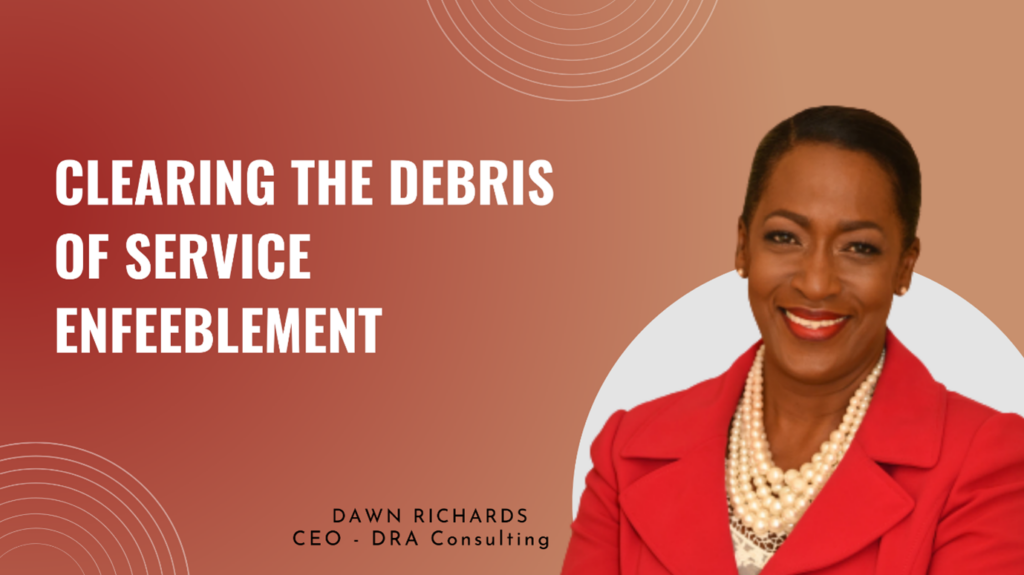Some businesses are used as the prevailing brand standards for poor service delivery. That’s a major reputational indictment. They are cited everywhere and by everyone for their nonchalance towards creating the gift that every customer wants to receive….a positive experience. Yet, foot and digital traffic continue to drive acceptable and sometimes, superlative financial results. Sounds counterintuitive, doesn’t it?
There’s quite a bit of debris that prevents a business from becoming a point of reference for superlative customer experience in its industry. Debris in this context, refers to any matter that obstructs a clear path to a desired destination. Clearing debris therefore, can mean a huge uplift in the direction of service excellence. Let’s take a look at some low-hanging opportunities.
Applying a rudimentary level of analysis that extracts insights from customer data that is gathered from both formal and informal channels, will clear a bit of debris and bring statistical consideration into the decision-making cycle.
Debris in this context, refers to any matter that obstructs a clear path to a desired destination.
One particular insight that will be uncovered, would centre around the number of customers who would have left and those who would have joined the ranks of the customer base. The difference between these numbers will speak to a gain, loss or break-even position. Another useful insight would be the discovery of how many first-time customers returned to conduct business and kept returning, specifically because their customer experience expectations were being met. When these two numbers are juxtaposed and interrogated, they will divulge how much of the customer base of a business is transient and how much is constant or repetitious.
The overarching point that I am making here, is that superior financial results may not be rendered necessarily, through repeat business, contributed by an institutionalized customer cohort. These results may come through a continuous cycle of adding new customers (depending on the marketing and branding spend), even as unhappy or under-satisfied customers leave. Some businesses are oblivious to their net numbers and continue to be wedded to a model where huge amounts of effort and money are dedicated to supporting this constant trawling for new customers.
A commitment to perpetual improvement in the area of customer experience will remove considerable ideological debris. Far too many businesses are wedded to the normalization of minimum effort. Continuous stretching is not a part of their cultural tapestry and so, no aspiration to achieve either incremental, or seismic change exists to push the business to be relentless in sustaining its journey to service excellence.
If customers are coming and going, it can be easy for a business to fall prey to subconscious rigging of its mentality around a “we’re doing well” attitude.
A false sense of customer loyalty, because of the prevailing absence of service catastrophe, is another piece of attitudinal debris to be discarded. If customers are coming and going, it can be easy for a business to fall prey to subconscious rigging of its mentality around a “we’re doing well” attitude. A closer look at the data analytics associated with the traffic may be eye-opening for many businesses.
The ostrich effect, (the tendency to ignore, avoid or deny negative information or situations), contaminates many businesses with its ability to sustain deliberate blindness to adverse situations. This is a common practice that can ossify a business around an apathetic response to keeping customers happy. Leaders lull themselves into believing that if there are only minor customer infractions that do not pose a calamitous threat, then all is well, especially if the situations blow over without serious repercussions or irreparable diminution in revenue. Meanwhile, service excellence moves further and further away as an achievable goal.
Another piece of debris that litters the path to customer fandom, is the absence of accountability for ensuring the achievement and survivorship of service excellence. I encounter countless businesses that have absolutely nothing in place for ensuring that standards of care are defined, established, monitored, reinforced and enforced.
So, for those businesses that may be interested in clearing their debris, start by quantifying the cost of poor service delivery.
These businesses deploy training programs that target primarily those employees who are deemed “high customer contact staff,” not realizing that all employees should be so classified. Hence, all staff should be trained to deliver a superlative customer experience, because what happens inside, will invariably spill over to the outside. Superlative internal customer experience therefore, should translate into superlative external customer experience.
The last piece of debris that I want to spotlight, is that of the alarming dearth of subject matter expertise resident in businesses, in the areas of customer experience and service excellence. Given the ubiquitous impact of service delivery, all leaders should be able to speak authoritatively on the subject of service excellence.
So, for those businesses that may be interested in clearing their debris, start by quantifying the cost of poor service delivery. The figure is certain to get everyone’s attention and accelerate action.

